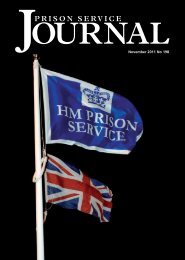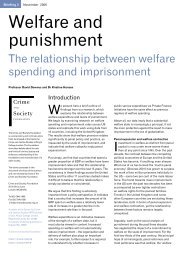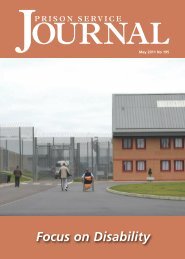PRISON SERVICE
PRISON SERVICE
PRISON SERVICE
- No tags were found...
Create successful ePaper yourself
Turn your PDF publications into a flip-book with our unique Google optimized e-Paper software.
supervision. Lack of role clarity, where roles are perceiveddifferently by the staff and by management, may result instaff stress.Physical environmentPhysical environment also constitutes a health andsafety risk, with prison officers ranking second only topolice officers in the number of workplace non-fatalviolent incidents. Prison officers frequently perceive aconstant threat of danger from those they supervise, withthe suggestion that the threats are higher in maximumsecurityinstitutions. This is consistent with reports ofhigher rates of illness in prison officers in maximumsecurityprisons compared with minimum security ones 13 .However, the risk of physical danger is significantly higherfor prison officers than fortreatment staff, and so the findingof Armstrong and Griffin 14 thatthere were no differencesbetween the two groups in jobstress and stress-related healthconditions raises questions aboutthe specific weighting ofenvironmental stress on stress andhealth outcomes. They found thatthe strongest predictors of jobstress for custodial staff were roleproblems (conflict over differingand ambiguous job demands),while lack of intrinsic rewards, lackof co-worker support, lack oforganizational support, andenvironmental safety were othersignificant contributors. Fortreatment staff, the findings weresimilar. For stress-related health problems, role problemswere again strong predictors of physical symptoms, alongwith lack of organizational support. Interestingly, fortreatment personnel, and to a lesser extent prison officers,a second strong predictor of health problems was lack ofintrinsic rewards on the job, while environmental safetyalso acted as a predictor of health problems for prisonofficers. As might be anticipated, demographic variablessuch as being female, being younger and shorter durationof employment in the prison system were also associatedwith increases in stress and health problems. These data,which have the additional strength of being based on alarge sample of the total state correctional facility staff,confirm the anticipated linkages of stress and stressrelatedhealth problems, but point to management issuessuch as job role problems and lack of organizationalPhysicalenvironment alsoconstitutes a healthand safety risk, withprison officersranking second onlyto police officers inthe number ofworkplace non-fatalviolent incidents.support (and the presence or absence of intrinsic rewardsin the job) as being of equal or greater import thanenvironmental safety in predicting stress and stress-relatedhealth problems. The clear implication of these findings isthat management issues may be of equal or greatersignificance than anticipated prisoner violence in theproduction of stress-related illness such as headaches,fatigue and stomach upsets. Armstrong and Griffinconclude that apart from perceptions of personal safety,sources of stress (as well as protective factors againststress) were similar in both custodial and treatment staffgroups, with environmental factors having the strongestimpacts.Predictors of Workplace Stress and Poor HealthA study by Ogi ska-Bulik 15among uniformed personnel,including a large sample of prisonofficers, in Poland suggests that thepredictors of workplace stress havecommonalities in prison officersacross western cultures. Ogi ska-Bulik used measures of stressrelatedillnesses (somaticcomplaints, anxiety and insomnia,social functioning disorders, andsymptoms of depression). Thelowest level of stress, the highestdegree of a sense of socialcoherence, and the highest degreeof social support (along with thebest health status) was found inprison officers, in comparison withthe other uniformed servicemen(i.e. police, firefighters, securityguards, city guards). Ogi ska-Bulik also found, as didresearch in North America, that the best predictors ofhealth status were stress at work, and amount of socialsupport. Thus, high workplace stress is associated withpoorer health, and good social supports help to bothreduce stress at work and be associated with betterhealth. As in most other research on workplace stress,actual levels may depend on particular prisonorganizational and physical environments: thus, the levelof stress compared with other uniformed professions mayvary between and within countries.Blood-born DiseaseTaking an apparently very different health-relatedissue in prison staff, the risk of contracting blood-born13. Lindquist CA, Whitehead JT (1986) see n.11.14. Armstrong GS, Griffin ML (2004). See n.4.15. Ogisnka-Bulik N (2005). The role of personal and social resources in preventing adverse health outcomes in employees of uniformedprofessions. International Journal of Occupational Medicine and Environmental Health 18:233-240.58 Prison Service JournalIssue 192











